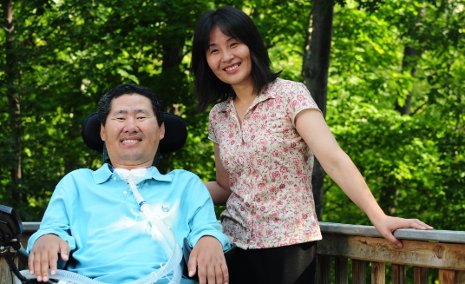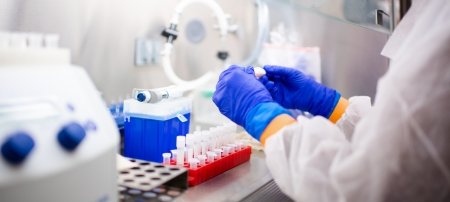Michigan Tech Mathematicians Identify Genes Linked to Lou Gehrig's Disease

Michigan Technological University researchers have linked three genes to the most common type of amyotrophic lateral sclerosis (ALS), generally known as Lou Gehrig’s disease.
Shuanglin Zhang, who holds the Richard and Elizabeth Henes Professorship in Mathematical Sciences, leads the team of mathematicians that isolated the genes from the many thousands scattered throughout human DNA. He notes that their discovery does not mean an end to ALS, but it could provide scientists with valuable clues as they search for a cure.
It can’t come any too soon. Zhang started showing symptoms of the disease himself four years ago. He now breathes with support from a respirator and works at home with the aid of a research assistant and his wife, Qiuying Sha, an assistant professor and member of his research team.
“I felt very urgent to find the genes for ALS,” he says.
“This is very nice work,” said Xiaofeng Zhu, an associate professor of epidemiology at Case Western Reserve University’s School of Medicine. “It’s very challenging to map genes for complex diseases, and while many statistical methods have been developed, most don’t work well in practice. Zhang’s group has developed a method to detect genes and gene-gene interaction in complex diseases and provided evidence that it works.
“Their findings will need to be confirmed by other researchers, but I think this will be very useful for the investigators who are trying to find genes underlying complex diseases such as ALS,” said Zhu.
According to the ALS Association, only about 10 percent of patients have familial ALS, a directly inherited form of the usually fatal neuromuscular disorder. The remaining 90 percent, including Zhang, are diagnosed with the sporadic form of the disease. While scientists have long suspected that genetics plays a role in sporadic ALS, they have had no evidence to back it up, at least until now.
Everyone has the three genes in question. But in people with sporadic ALS, they differ from those in people who don’t have ALS.
The mathematicians were not surprised when they tracked down the genes’ street address. “Everybody has 23 chromosomes, and the three genes on chromosomes 2, 4, and 10 interact,” explained Sha. “If you have this combination of the three genes, you are at high risk of developing the disease.”
“It’s really exciting, especially because my husband has sporadic ALS,” she adds. “Maybe they can find a cure by blocking the genes.”
According to the ALS Association, approximately 30,000 Americans have ALS, and about 5,600 new cases are diagnosed every year. The disease destroys the nerves in the brain and spinal cord that control voluntary movement, eventually leading to paralysis.
Zhang’s team used a new statistical method to analyze the genetic codes of 547 individuals, 276 with sporadic ALS and 271 without. Their method, a two-locus interaction analysis approach, allows the researchers to identify multiple genes associated with a complex illness.
The data set they analyzed was provided by National Institute of Neurological Disorders and Stroke (NINDS) Human Genetics Resource Center at the Coriell Institute (http://ccr.coriell.org/ninds), a publicly funded "bank" or repository for human cells, DNA samples, clinical data, and other information that aims to accelerate research on the genetics of nervous system disorders.
“Ideally, we should confirm our results in a second data set, but we don’t have one available,” Sha says.
ALS is not the first condition they have tackled. Using data sets provided by University of Cambridge, Zhang, Sha and their colleagues have also identified 11 genes linked to type 2 diabetes, which has reached epidemic proportions in the U.S.
The team hopes to apply their methods to other medical conditions, but has been hampered by the lack of genetic information: most data sets are not freely available to researchers. Zhang found out about the ALS data sets serendipitously, while searching the ALS Association website for information on his condition.
“Unfortunately, we don’t have access to more data sets,” said Sha. “If we did, we could analyze even more diseases.”
Their work is being funded by a grant from the the National Institute of General Medical Sciences, part of the National Institutes of Health. A paper detailing their work, “Genome-wide Association Reveals Three SNPs Associated with Sporadic Amyotrophic Lateral Sclerosis through a Two-locus Analysis,” is published in the open access journal BMC Medical Genetics. In addition to Zhang and Sha, the other coauthors are Zhaogong Zhang from Michigan Tech and Jennifer Schymick and Bryan Traynor of the National Institutes of Health.
Michigan Technological University is an R1 public research university founded in 1885 in Houghton, and is home to nearly 7,500 students from more than 60 countries around the world. Consistently ranked among the best universities in the country for return on investment, Michigan's flagship technological university offers more than 185 undergraduate and graduate degree programs in science and technology, engineering, computing, forestry, business, health professions, humanities, mathematics, social sciences, and the arts. The rural campus is situated just miles from Lake Superior in Michigan's Upper Peninsula, offering year-round opportunities for outdoor adventure.




Comments